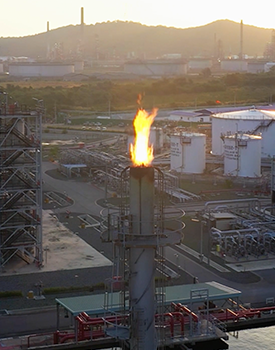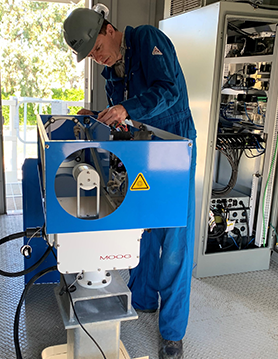Mass Flux Radial Plume Mapping
This is an advanced open-path ambient air monitoring technique approved by the USEPA in OTM-10. It can provide great insight into process operations in that it can assess both wind and concentration data to provide a mass flux of pollutants crossing a fixed boundary or likely emanating from a fixed asset (like a pit, pond, lagoon, water treatment area or remedial activity). Mass Flux Radial Plume Mapping monitoring services are available for limited duration field implementation and are frequently compared to mathematical models or emission factor calculations.
Passive FTIR
Spectrum utilizes its Passive Fourier Transfer Infrared Spectroscopy (PFTIR) technique to conduct performance testing of industrial flares. This work is executed using our proprietary “radiance software” and technology that is patent-protected under U.S. Patent No. 9146195. The technique allows one to test an active operational flare in the field while in-duty.
The testing is performed in a manner technically consistent with prior PFTIR flare testing such as those tests conducted by the TCEQ in 2010 or other recent USEPA Flare Consent Decree testing.
This detailed testing approach has been reviewed and validated by the TCEQ and USEPA, and the results of these historical tests became the basis of the USEPA’s updated AP-42 emissions factor guidance issued in February 2018. The combustion efficiency and CO emission rates are directly measured with a PFTIR as the flare’s fuel flow and steam/air-assist rates are adjusted.
To determine the combustion efficiency achievable and CO emissions associated with a flare, Spectrum performs testing under a variety of controlled operating scenarios. To compute combustion efficiency, the concentrations of CO, CO2, and Total Hydrocarbon (THC) are measured to compute: Eff = [CO2]/([CO2]+[CO]+[THC]+[soot] )
If soot is present at any significant concentration, it will be seen in the IR spectra as an attenuation of the signal with characteristic spectral shapes driven by particle size distribution. Normally, testing is not conducted when visible emissions (represented by soot in the combustion zone) are evident.
The USEPA does not have a required flare testing methodology. However, the PFTIR approach has been well documented in various agency testing and enforcement matters and is acceptable to most regulators. Many flare manufacturers voluntarily conduct combustion efficiency tests to demonstrate the adequacy of their designs.
The number of test scenarios will be identified and agreed to prior to Mobilization. A single PFTIR instrument is provided by Spectrum and is normally situated approximately 90° from the predominant wind direction to allow for accurate plume sampling. The PFTIR is capable of analyzing multiple spectra per minute. Therefore, 15 minutes per test condition provides ample time for a stable measurement at each operating condition.
This Passive FTIR technique for flare testing was pioneered by the late Dr. Robert Spellicy while he and several other Spectrum scientists worked together at IMACC. Spectrum continues to improve this technology and is today the holder of this unique patented approach.



